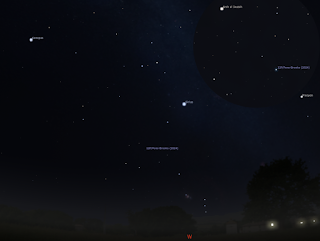Tuesday, May 28, 2024
Thursday May 30 to Thursday June 6
The last Quarter Moon is Friday, May 31. Comet 12P Pons-Brooks is visible when the sky is fully dark but remains a binocular only object. The comet leave the iconic Orion constellation behind and moves into Canis Major. In the morning the Moon moves down the lineup of Saturn, Mars and Mercury. Despite claims of a rare alignment of planets being visible to the unaided eye on June 3, the actual alignment on June 5 will be difficult to see.
The last Quarter Moon is Friday, May 31. The Moon is at perigee, when it is closet to earth, on June 2.
The comet has faded to magnitude 6, and you need binoculars. With the Moon rising out of the way the comet is easier to see now. Over the week the comet will climb higher into darker skies heading towards Canis Major. Updated spotters charts are here.
Similar views will be seen from the rest of Australia at the equivalent local time (90 minutes after sunset).
Elsewhere in Australia will see a similar view at the equivalent time (90 minutes after sunset).
Mercury sinks into the twilight and is soon lost to view. Mercury and Jupiter are close on the 5th.
Venus is lost in the morning twilight.
Mars is rising in the morning twilight. Mars is close to the crescent Moon on the 3rd.
Jupiter returns to the the morning twilight sky. Mercury and Jupiter are close on the 5th.
Saturn climbs higher in the morning twilight. Saturn is close to the crescent Moon on the 1st.
Star Map via Virtual sky. Use your mouse to scroll around and press 8 when your pointer is in the map to set to the current time.
Cloud cover predictions can be found at SkippySky.
Here is the near-real time satellite view of the clouds (day and night) http://satview.bom.gov.au/
Labels: weekly sky





 Click to read about or order
Click to read about or order Click to read about or order
Click to read about or order Click to read about or order
Click to read about or order Click to read about or order
Click to read about or order